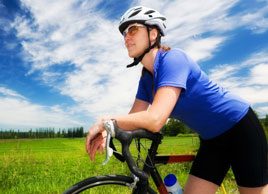The benefits of biking
Why cycling is so good for your body and mind’plus, how to pick the gear that’s right for you

Source: Best Health Magazine, October 2009
More and more women are rediscovering the fun of riding a bike, whether it’s joining a group of friends to ride local trails, taking in a combo spinning/yoga class, or simply zipping around the neighbourhood to do errands or enjoy a family outing. (And, hey, reducing your gasoline budget’and your greenhouse gas emissions’doesn’t hurt, either.) Recreational cycling has all kinds of health benefits, too, including burning a ton of calories. Here’s what you need to know to get the most out of your bike ride.
Physical and mental payoffs
‘Cycling helps you develop fantastic lower body strength: your quadriceps, hamstrings and buttocks,’ says Jenny Brown, a fitness trainer and women’s cycling coach at Reactivated in St. Catharines, Ont. ‘You develop toned muscles without bulk.’ You also strengthen core muscles because you’re working on keeping balanced and upright, adds Patti Fletcher. a bike-shop owner and women’s cycling instructor in Comox, B.C.
As well, cycling is a low-impact sport and tends to be easy on the joints (as a teenager, Brown took up competitive cycling because knee problems sidelined her from other sports). The varied intensity of biking’working at a moderate pace on a flat stretch, then pushing harder on an uphill climb, then returning to another less intense flat stretch but maybe riding into the wind this time’helps you build a strong cardiovascular system, too.
Cycling is often as good for the spirit as it is for the body. Research published in 2008 in the British Journal of Sports Medicine found that study participants with depressive and anxiety disorders who cycled for 20 minutes reported decreased levels of anxiety, and those who picked the level of intensity they wanted to ride at reported an increase in well-being.
Get the right gear
If you are in the market for a new bicycle, one designed for women (known in the cycling industry as a women specific design or WSD) is a good way to go. ‘Women’s proportions are different from men’s, so the WSD has appropriate proportions to prevent neck and back strain, rather than just being a smaller man’s bike,’ Brown explains. ‘The handlebars, brake levers and grips are smaller for smaller hands, and the saddle is bigger for a woman’s pelvis.’
While much of the research on bike saddles has focused on men (a hard, narrow saddle can contribute to erectile dysfunction as well as blood flow problems), women can end up with a sore crotch from chafing after a long ride, so make sure your saddle is positioned properly or consider a model with cut-out sections to decrease pressure on delicate tissue.
Another option is padded shorts. ‘They do feel a bit like a diaper when you first put them on, but they are absolute heaven when you ride,’ says Brown. ‘They give you extra padding for protection, and they’re seamless so you don’t experience chafing. If you’re self-conscious about a tight pair of shorts, look for a baggier version that has a built-in padded lining.’ There’s no need to wear underwear (remember, you want no seams) and be sure to change out of the shorts soon after your ride so you aren’t providing a moist breeding ground for a yeast infection.
Top it all off with a bike helmet. To check proper fit, use the 2-V-1 method advocated by ThinkFirst, a national organization for brain and spinal cord injury prevention: First, there should be a space of two finger widths between the bottom of the front of your helmet and your eyebrows. Next, put your fingers in a V-shape around the bottom of each ear and make sure the straps are lining up with your fingers. Last, slip one finger between your chin and the strap, to make sure your chinstrap is snug and that it doesn’t move forward or back.
Ready? Ride!
This article was originally titled "Ready, set, ride!," in the October 2009 issue of Best Health. Subscribe today to get the full Best Health experience’and never miss an issue!’and make sure to check out what’s new in the latest issue of Best Health.




